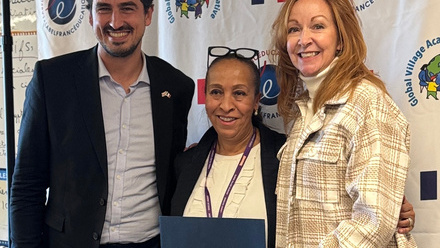School Nutrition: Confronting the Rural Reality
Across rural Colorado, students face an overlooked but pressing challenge: access to healthy, affordable school meals. For many families, economic hardship, geographic isolation, and food deserts make it difficult to secure nutritious food – and for rural charter schools – providing consistent, high-quality meals remains an uphill battle. Meal vendors and fully equipped school kitchens are scarce while costs often exceed available funding.
To shed light on these realities — and the innovative solutions emerging from within — the League is launching the Rural School Food Series. It will document the experiences of charter schools working to better school nutrition with the support of the Rural School Food Project (RSFP), a two-and-a-half-year initiative dedicated to improving meal access and nutrition in rural schools.
A Holistic Approach
Running from July 2024 to December 2026, the RSFP is designed to increase access to nutritious and affordable food for 12 rural charter schools across nine counties in western and northern Colorado. These schools serve small, rural communities that face distinct challenges, from food deserts to economic barriers, limiting access to healthy meals.
But RSFP is more than just funding—it’s about empowering schools with resources, training, and strategic partnerships to create lasting change.
Each participating school receives up to $15,000 in sub-awards based on their specific needs, helping them secure key kitchen equipment such as hoodless ovens, steam tables, salad bars, dishwashers, warmers, and transport van upgrades. These enhancements open the door to more sustainable meal programs, ensuring that students have access to fresh, healthy, and culturally relevant meals.
Overcoming Barriers
To better understand the systemic challenges facing rural charter schools, we spoke with Ilene Agustin, Director of School Nutrition at the Colorado Charter School Institute (CSI). She highlighted two primary issues.
The first is that most rural charters “lack a kitchen space to prepare food, forcing them to need a meal vendor. The second is there are no meal vendors in rural areas, so we are having to work with restaurants that do not understand the National School Lunch guidelines.” That means, she says, that these restaurants are driven by making a profit, so schools are paying more for meals than they are getting in federal reimbursement.
When they are lucky, she says, they can use the district as a vendor. For schools like North Routt County Community School, which is losing its long-standing vendor though, finding a replacement has proven difficult due to a remote location and lack of a commercial kitchen. In situations like this, Agustin sees two potential solutions.
Thinking Outside the Box
“They either need to find the money to purchase equipment to prepare the meals themselves, which will allow them more autonomy, or … work with local restaurants or businesses to vend their food” at a price they can afford, says Agustin.
One inspiring example comes from Kwiyagat Community Academy. Faced with limited options, the school partnered with a local casino to prepare student meals. Agustin coordinated with the casino and the school to develop a four-week meal cycle. The casino, in turn, worked with Shamrock to create compliant recipes and production records.
“The biggest lesson here is that schools must think outside the box,” says Agustin. Consider, ‘What potential partners live in the area and how could they help you to create a meal program to feed your students?’”
As we launch this Rural Charter School Food Series, we invite you to follow along as we share the journeys of these twelve charter schools who are setting a new standard for what’s possible in rural school nutrition.






